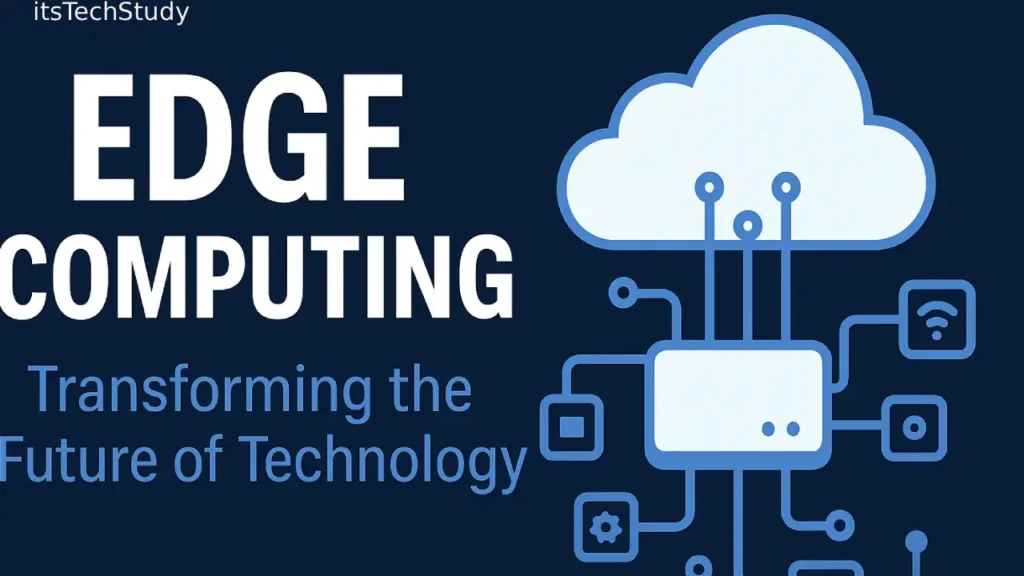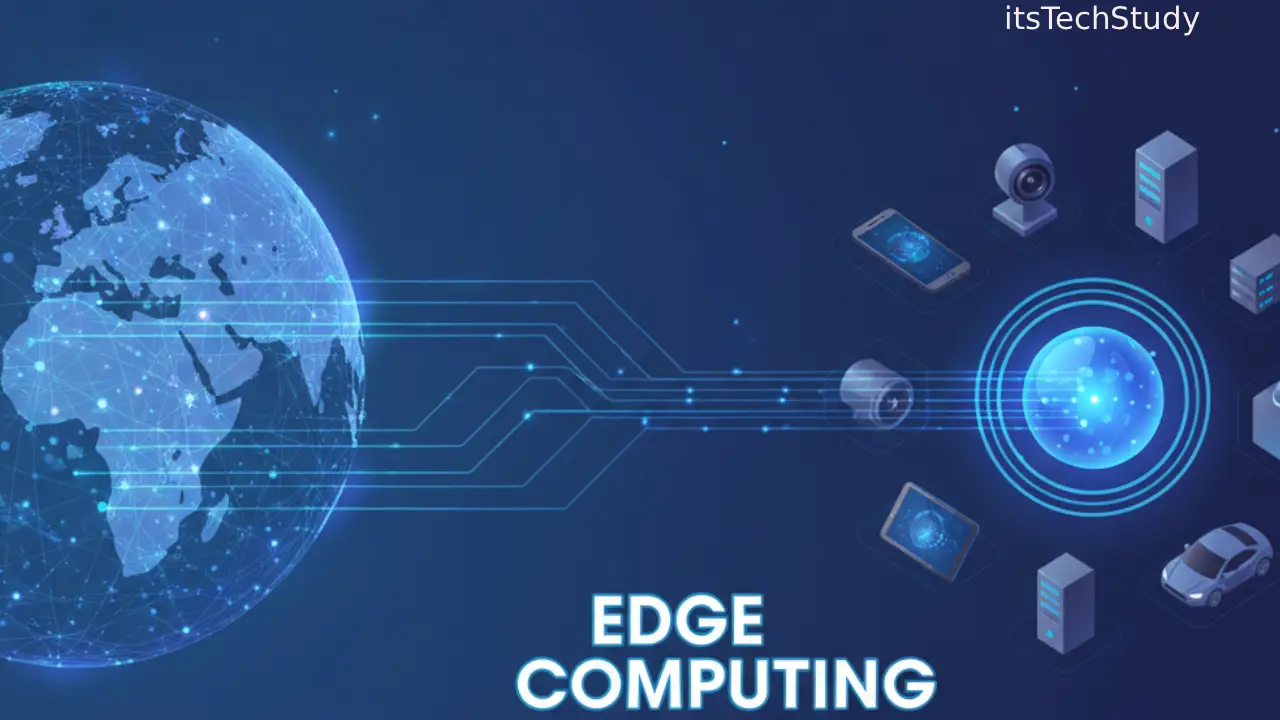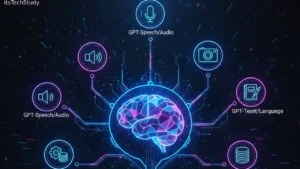Introduction: Why Edge Computing Matters Today
Technology is moving faster than ever before. From AI developments to intelligent devices, all of these technologies produce huge amounts of data that must be analyzed in real time. Historically, most of this data has been shipped off to cloud servers for analysis. Although the cloud is still a mighty underpinning of digital infrastructure, it is not always quick and efficient enough for applications requiring real-time responses.
That is where edge computing enters the scene. By bringing computation nearer where data is being generated-be it a sensor in an intelligent factory, a networked automobile, or a fitness device worn on the body-edge computing decreases latency, enhances efficiency, and opens up new possibilities.
But why is it so crucial now? The proliferation of IoT devices, autonomous cars, smart cities, and the growing need for real-time applications make classic cloud configurations unable to keep up with all of it without any hitches. Edge computing bridges this much-needed gap, making it one of the new technology trends of 2025.
In this article, we’ll explore what edge computing is, how it works, its benefits and challenges, real-world applications, and why it is considered a game-changer for the future of technology.
What Is Edge Computing?

In simple terms, edge computing is a distributed computing model that processes data closer to the source rather than sending it all the way to a centralized cloud or data center.
Suppose you’re working with a smart home assistant. If each voice command had to be sent thousands of miles to a far-away server before getting back an answer, even a one-second latency would feel sluggish. With edge computing, processing can take place nearby, providing you with a snappier and smoother experience.
Key Features of Edge Computing:
- Low Latency: Quicker processing of data close to the origin.
- Bandwidth Efficiency: Reduced necessity to transmit huge volumes of data to the cloud.
- Real-Time Insights: Most important in healthcare, manufacturing, and transportation industries.
- Scalability: Functioning perfectly well with billions of connected devices.
How Edge Computing Functions
Essentially, edge computing puts the computing resources on smaller, local devices or servers that are located near users or IoT endpoints.
- Data Collection: Raw data is created by sensors, devices, or machines.
- Local Processing: Instead of transmitting everything to the cloud, the edge device (e.g., a gateway, local server, or embedded computer) processes it immediately.
- Decision Making: For critical, time-sensitive tasks, decisions are made on-site.
- Cloud Integration: Only necessary or summarized data is sent to the cloud for deeper analysis or long-term storage.
This combination of local speed and cloud intelligence provides the best of both worlds.
Edge Computing vs. Cloud Computing
While cloud computing will remain vital, it has limitations when handling real-time applications. Let’s break down the differences.
| Feature | Edge Computing | Cloud Computing |
|---|---|---|
| Latency | Very low (near-instant processing) | Higher (depends on network distance) |
| Data Processing | Local, at or near the source | Centralized in remote servers |
| Bandwidth Use | Minimal (only essential data sent) | High (large data transmission) |
| Use Cases | IoT devices, autonomous cars, AR/VR | Data storage, AI model training, backup |
| Scalability | Distributed across many devices | Highly scalable in centralized systems |
| Cost Efficiency | Reduces bandwidth costs | Flexible pricing, but can be costly for real-time apps |
Bottom Line: Edge computing does not substitute for cloud computing. They are best used together in a hybrid configuration.
Advantages of Edge Computing
Pros:
- Improved Response Times: Suitable for time-critical applications such as autonomous vehicle driving and medical monitoring.
- Lower Bandwidth Expenses: Conserves money by restricting data transfers to the cloud.
- Improved Privacy: Data remains nearer to where it was created, lowering exposure to cyberattacks.
- Reliability: Local processing keeps services going even when cloud connectivity is lost.
- Scalability with IoT: Ideal for controlling billions of devices without bogging down networks.
Cons:
- Deployment Complexity: Installation of edge infrastructure is skill-intensive.
- Security Risks: More distributed devices might result in more vulnerable entry points for hackers.
- Higher Initial Investment: Hardware and edge servers can be costly upfront.
- Management Challenges: Managing multiple nodes is more difficult compared to a single cloud.
Real-World Applications of Edge Computing

Edge computing is already reshaping industries. Let’s look at some strong use cases.
- Healthcare
- Real-time patient monitoring with wearables.
- AI-driven diagnostic tools for quicker decision-making.
- Smart Cities
- Optimization of traffic lights with edge AI.
- Public safety monitoring with edge-enabled surveillance systems.
- Manufacturing
- Predictive maintenance of equipment.
- Automated quality inspection with edge-enabled cameras.
- Autonomous Vehicles
- Real-time decision-making for navigation and obstacle avoidance.
- Vehicle-to-vehicle communication without reliance on the cloud.
- Retail
- Personalized shopping experience through in-store IoT.
- Smart checkout systems with edge AI.
Edge Computing in 2025: Trends Worth Watching
Edge computing is no longer a specialty tech—it’s mainstream. Some of the new technology trends 2025 reveal how it’s developing:
- 5G + Edge Synergy: Hyper-fast networks augment real-time processing.
- AI on the Edge: AI models executed directly on local devices.
- Sustainable Tech: Reduced energy consumption relative to cloud-based systems.
- Cybersecurity at the Edge: Enhanced encryption and zero-trust models.
- Edge in Remote Regions: Empowering smart farming and rural IoT.
These technology advancements illustrate why companies are spending big dollars on edge infrastructure.
Advice for Edge Computing Adoption by Businesses
- Begin Small: Test with pilot projects before going large.
- Secure It: Apply multi-layer security measures.
- Hybrid Approach: Leverage both cloud and edge for efficiency.
- Collaborate with Experts: Work with vendors who have expertise in edge deployments.
- Performance Monitoring: Utilize analytics to track ROI.
Conclusion: The Future of Edge Computing
With the digital environment becoming increasingly complex, edge computing is becoming one of the best tech solutions of 2025. From making autonomous vehicles possible to driving intelligent devices in daily life, edge computing processes data faster, more securely, and more efficiently.
For business and individuals alike, the message is clear: the technology future will be hybrid, with cloud and edge computing combining to provide seamless, intelligent, and real-time experiences.
By investing in edge computing today, businesses can remain competitive, tap the potential of tech innovations, and prepare for a smarter, more connected future.
Frequently Asked Questions (FAQ)
Q1: Is edge computing displacing cloud computing?
Ans: No. The edge supports the cloud. While the edge is performing time-sensitive operations, the cloud remains necessary for storage, AI learning, and batch analytics.
Q2: Which industries can most benefit from edge computing?
Ans: Healthcare, manufacturing, retail, automotive, and telecommunications are prime adopters because they require real-time data processing.
Q3: Is edge computing secure?
Ans: It can add security by making data local, but it also adds risk through distributed devices. Good encryption and surveillance are required.
Q4: How does edge computing enhance IoT?
Ans: IoT devices create tremendous volumes of data. Edge computing processes that data locally, enhancing performance, saving costs, and facilitating better decision-making.
Q5: What is the role of 5G in edge computing?
Ans: 5G enables the high-speed connectivity required to drive edge performance to the fullest, particularly for autonomous cars, AR/VR, and smart cities.
Q6: What are the biggest challenges for businesses adopting edge?
Ans: The biggest ones are high upfront costs, management complexity, and security across distributed systems.












No Comments Yet
Be the first to share your thoughts.
Leave a Comment